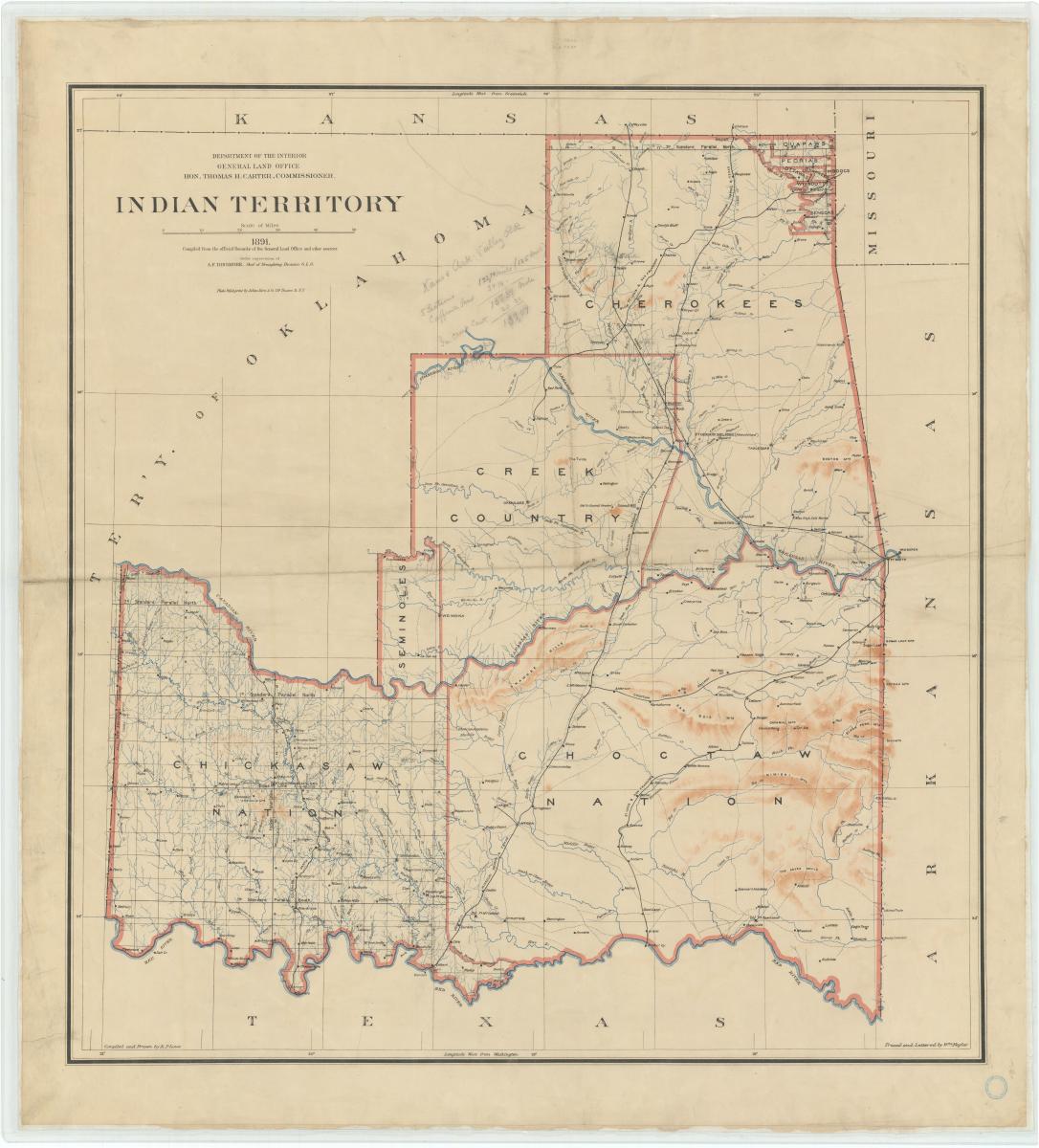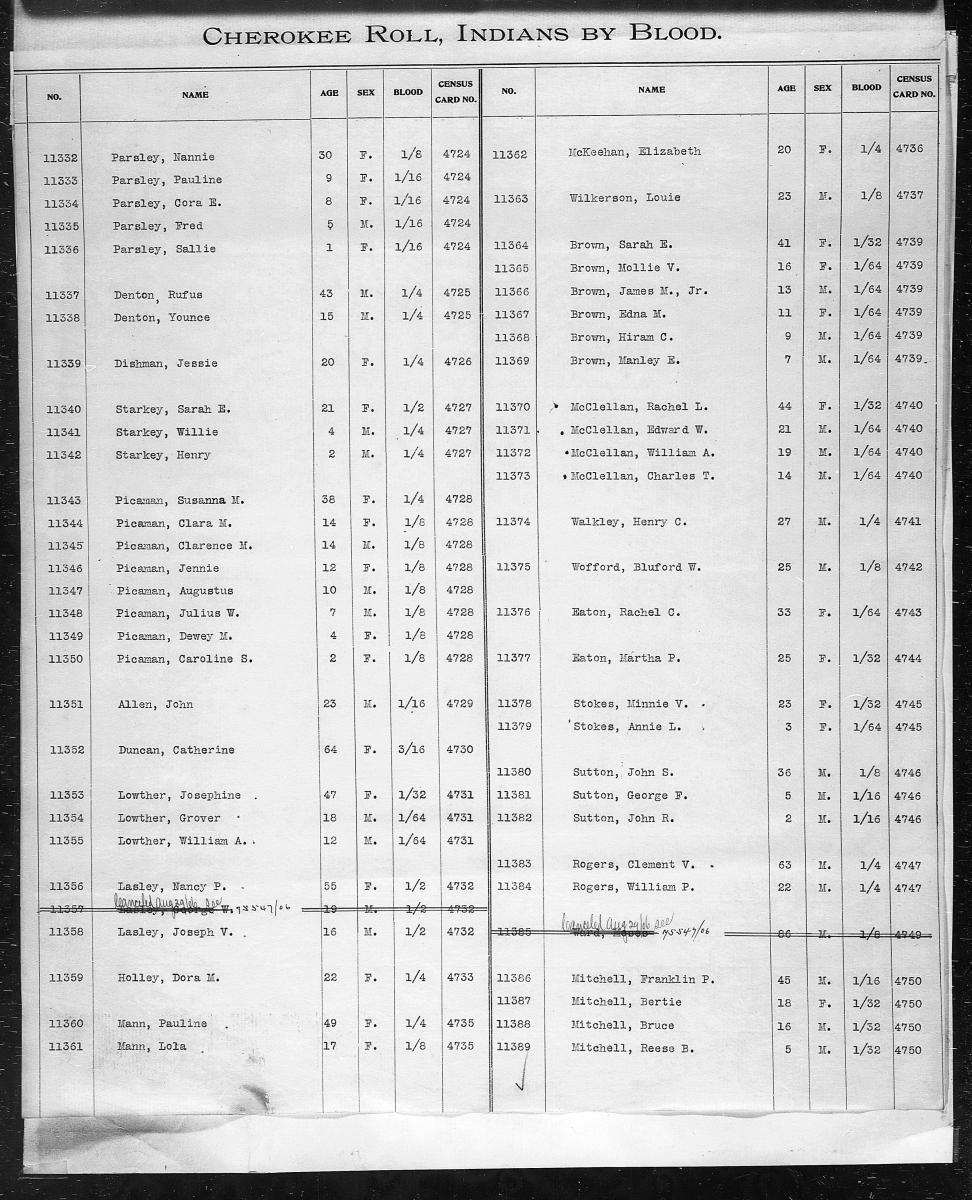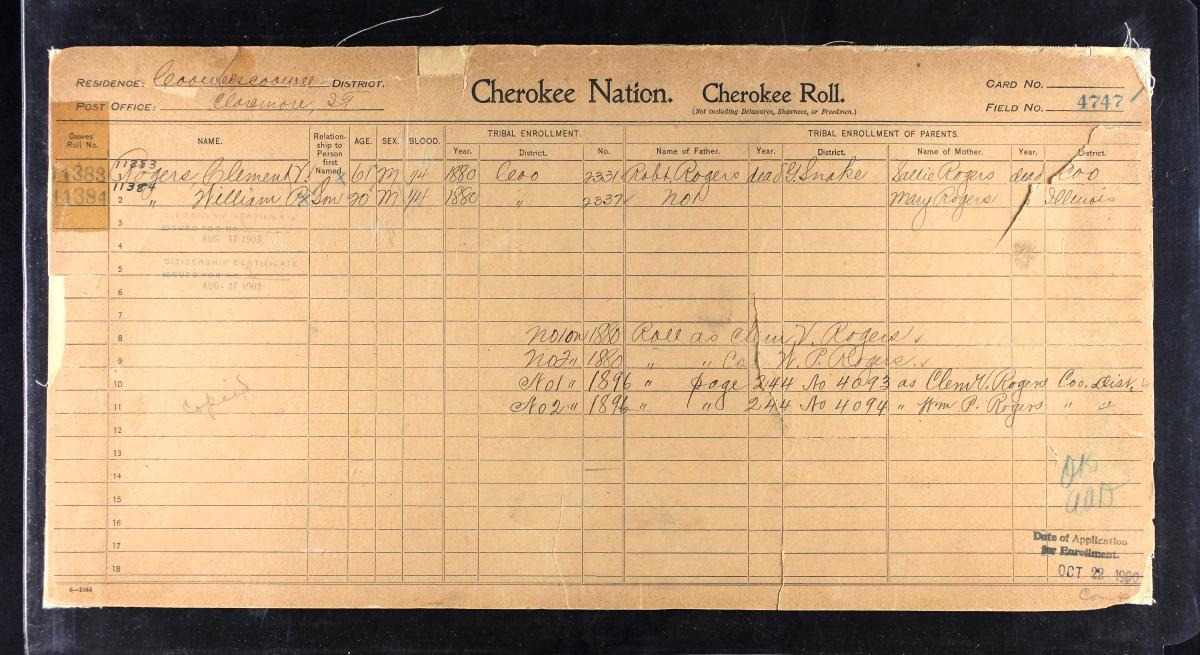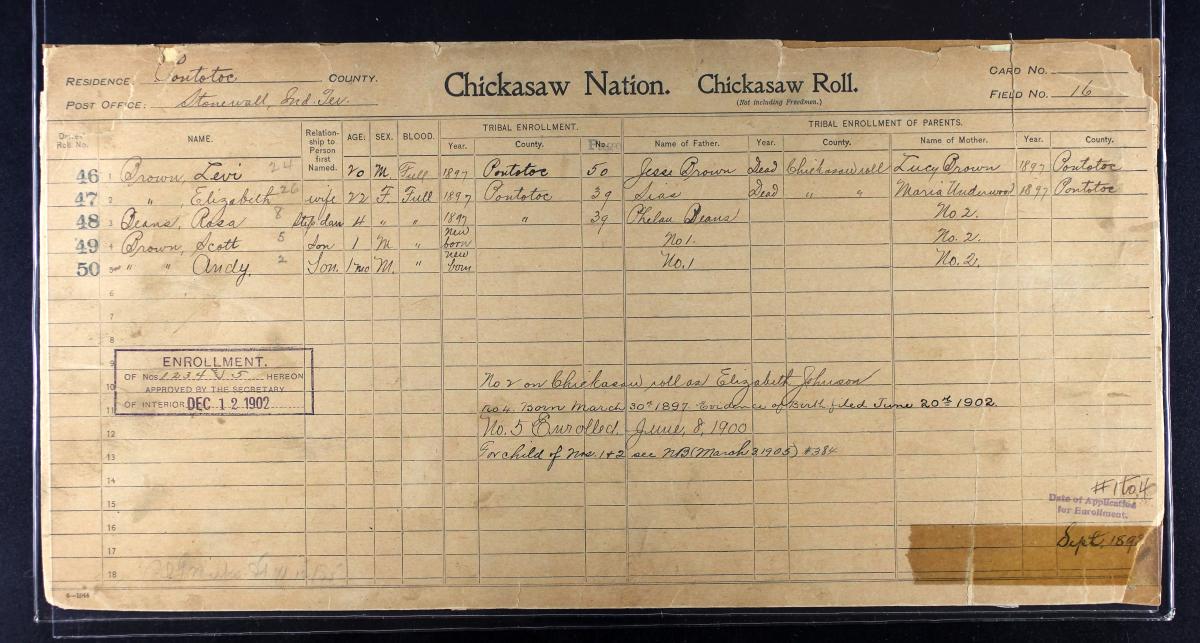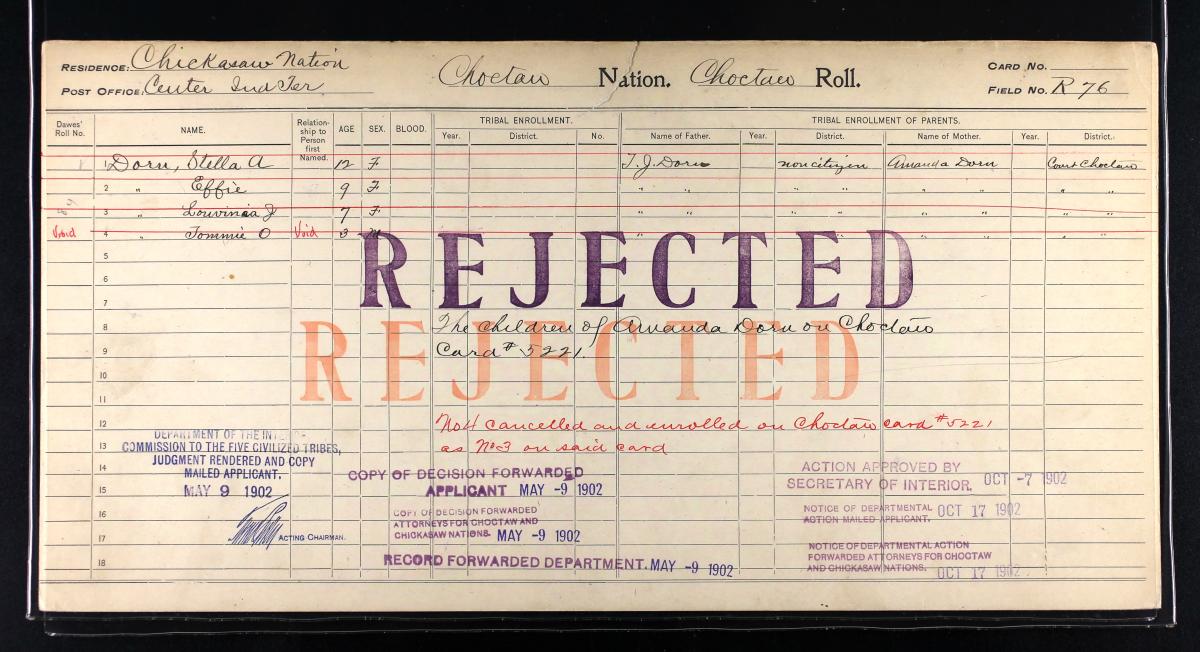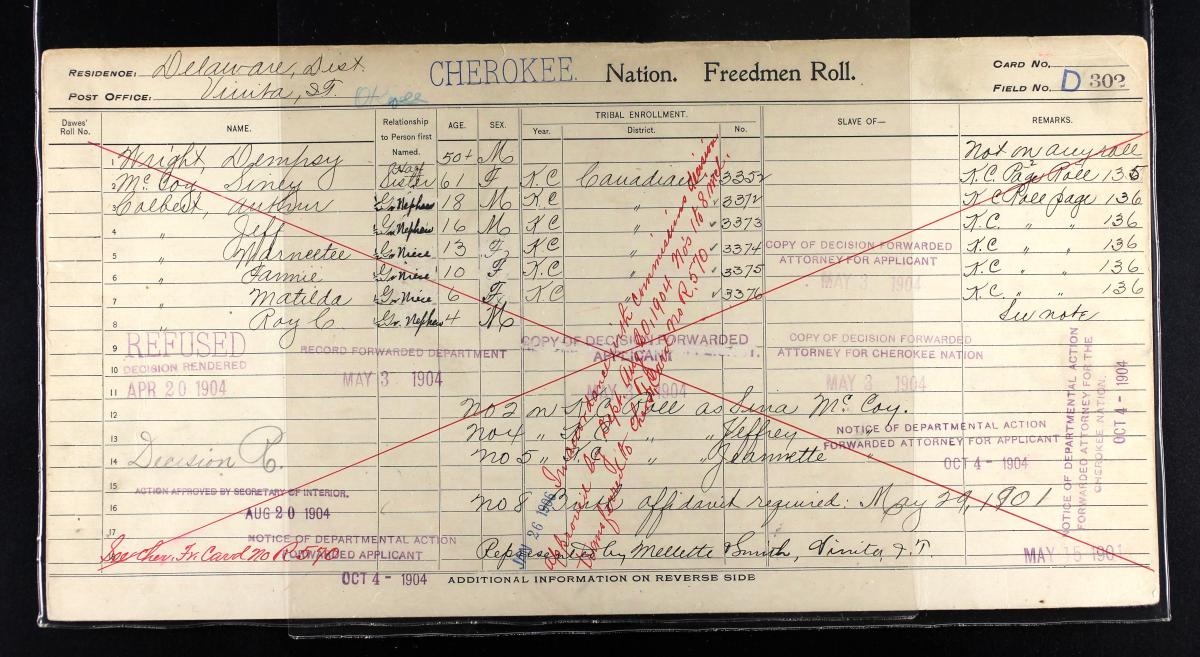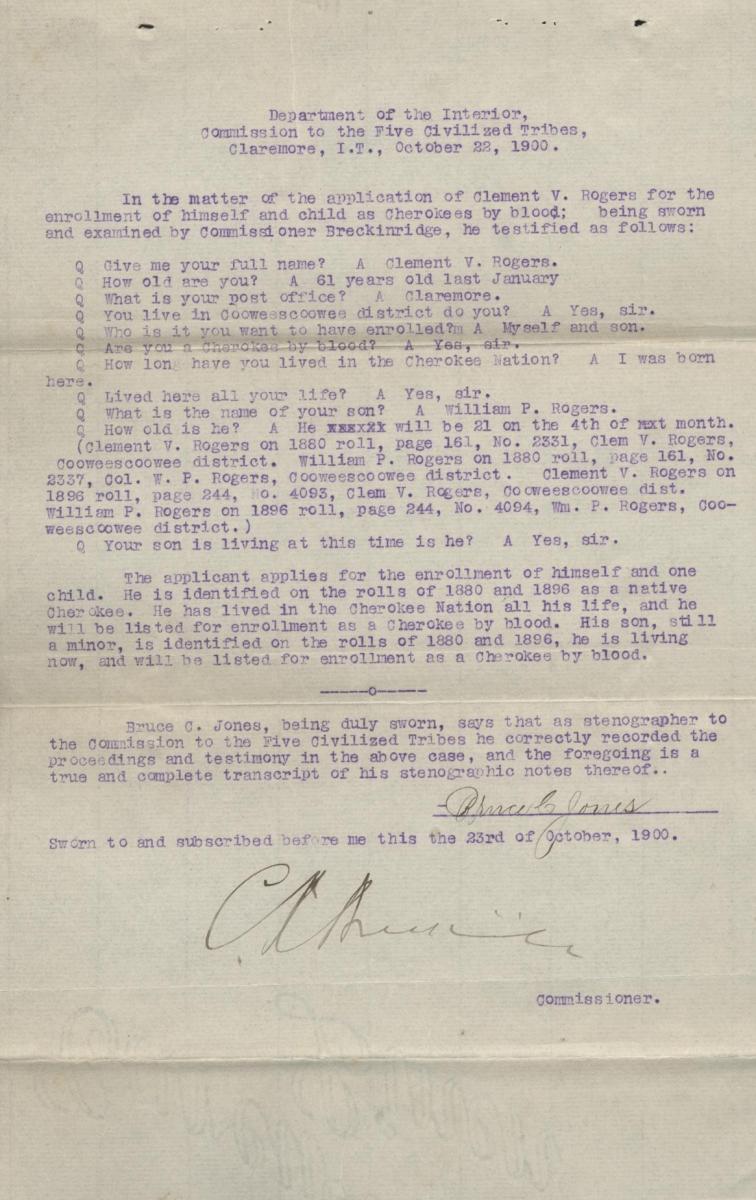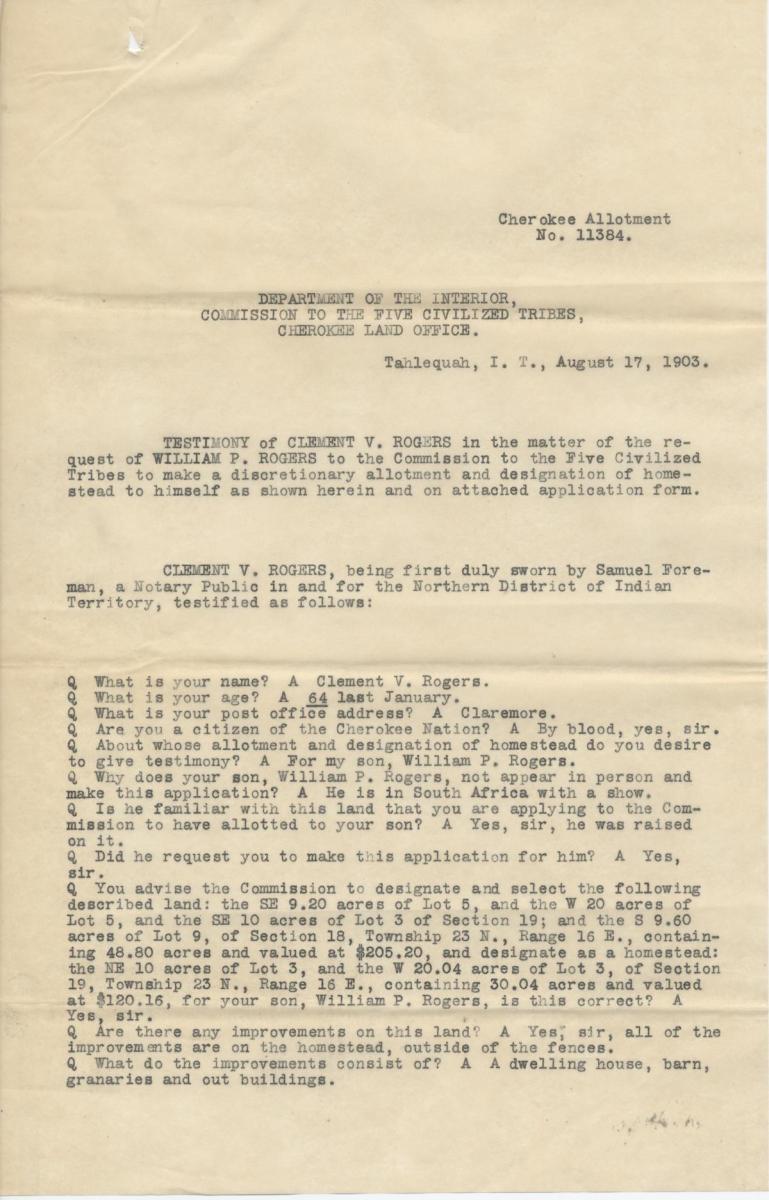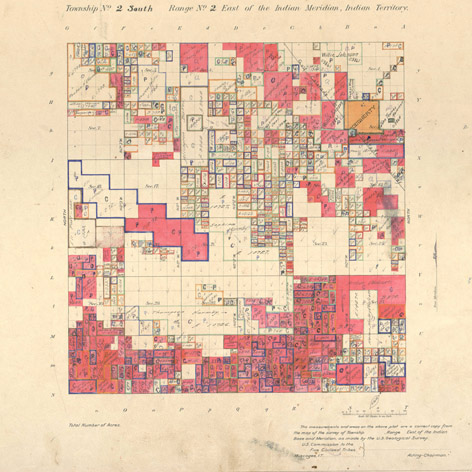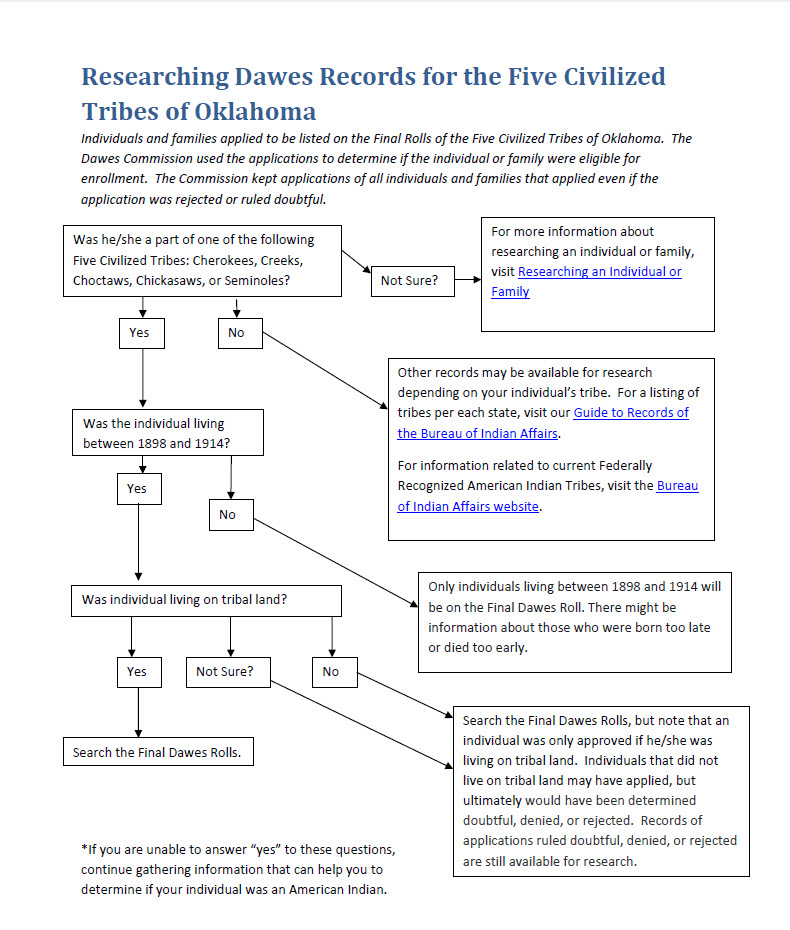
Dawes Records of the Five Civilized Tribes
The National Archives and Records Administration (NARA) has custody of the Final Rolls of the Five Civilized Tribes, known as the Final Dawes Rolls, as well as related census cards, enrollment applications, land allotment jackets, and maps. These records are found in Record Group 48, Records of the Office of the Secretary of the Interior, and in Record Group 75, Records of the Bureau of Indian Affairs.
The Final Dawes Rolls and related records are some of the most heavily used records at NARA for researching membership in the Cherokee, Choctaw, Chickasaw, Creek, and Seminole Nations in Indian Territory (present-day Oklahoma).
Background on the Dawes Commission
On February 8, 1887, Congress passed “An Act to Provide for the Allotment of Lands in Severalty to Indians on the Various Reservations," also known as the General Allotment Act or the Dawes Act. This law authorized the President to break up reservation land, which was held in common by the members of a tribe, into small allotments to be parceled out to individuals. Native Americans registering on a tribal "roll" were then granted allotments of reservation land. Learn more about the Dawes Act of 1887
The Dawes Act initially excluded the Cherokee, Choctaw, Chickasaw, Creek, and Seminole Nations in Indian Territory, who were collectively known as the Five Civilized Tribes. However, on March 3, 1893, Congress authorized the establishment of a commission to negotiate agreements with each of the Five Civilized Tribes that would abolish the tribal governments and permit the allotment of land to individual tribal members. Henry L. Dawes, a former senator from Massachusetts and the author of the Dawes Act, was appointed chairman of the commission on November 1, 1893, and it was commonly referred to thereafter as the Dawes Commission.
For two years, the Commission failed to convince tribal leaders to negotiate allotment agreements, as many tribal leaders did not support allotments or changes to existing treaties. Then, in 1895, Congress authorized a survey of Indian Territory, and in 1896 Congress authorized the Dawes Commission to add names to existing tribal rolls as a preliminary step to allotment. The Commission received more than 7,500 applications for enrollment and traveled throughout Indian Territory conducting hearings.
These applications, known as the 1896 applications, were declared null and void two years later, when Congress passed an act on June 28, 1898, authorizing the Commission to proceed with enrollment and allotment for the Five Civilized Tribes without tribal consent. The 1898 act, known as the Curtis Act, also provided for the termination of the Five Civilized Tribes’ tribal governments. By 1902, each of the Five Tribes had negotiated and ratified an agreement that modified the terms of the Curtis Act and became the basis for enrollment and allotment.
With new guidelines in place, the Dawes Commission accepted enrollment applications from 1898 through 1907, with a handful accepted in 1914. The Commission then prepared new citizenship rolls for each tribe, incorporating names of approved applicants while simultaneously documenting those who were considered doubtful and whose applications were ultimately rejected.
Upon approval of the rolls by the Secretary of the Interior, the Dawes Commission allotted a share of communal land to the approved members of these tribes. The Commission required that tribal members reside in Indian Territory to be considered for an allotment.
For more information about the Dawes Commission, see its organization authority record in the National Archives Catalog (National Archives Identifier: 10676932).
Dawes Records
The National Archives and Records Administration (NARA) has the following records created by the Dawes Commission:
- Final Dawes Rolls (also known as the Dawes Rolls or the Final Rolls of the Five Civilized Tribes)
- Dawes Census Cards (also known as the Dawes Enrollment Cards)
- Dawes Enrollment Applications (also known as the Dawes Enrollment Jackets or Dawes Testimonial Packets)
- Dawes Land Allotment Jackets (also known as the Dawes Applications for Allotment)
These records are digitized and available to research online. See below for details.
Final Dawes Rolls
The Final Dawes Rolls include approved and disapproved census rolls created by the Dawes Commission. Approved rolls list individuals who were accepted as eligible for tribal membership in the Cherokee, Choctaw, Chickasaw, Creek, or Seminole Nations (the “Five Civilized Tribes”), including Delaware adopted by the Cherokee, Mississippi Choctaw, and Freedmen (individuals who were formerly enslaved by the Five Civilized Tribes and their descendants). Individuals listed on the approved rolls were entitled to a land allotment. Disapproved rolls list individuals whose enrollment applications were stricken or rejected.
The series Final Rolls of the Five Civilized Tribes, 1899–1914 (National Archives Identifier: 608958) includes the approved and disapproved rolls. The approved rolls are digitized in the National Archives Catalog. The approved rolls are also microfilmed as NARA Microfilm Publication T529, Final Rolls of Citizens and Freedmen of the Five Civilized Tribes in Indian Territory (as Approved by the Secretary of the Interior on or Before Mar. 4, 1907, With Supplements Dated Sept. 25, 1914), 1907–1914.
The Final Dawes Rolls are arranged by tribe and thereunder by enrollment category. The rolls provide the following information about enrollees:
- Roll number (enrollment number)
- Name
- Age
- Sex
- Blood degree
-
Census card number
Note that the census card number can be used to identify an enrollee’s census card (enrollment card).
Dawes Census Cards
The Dawes Commission prepared census cards, also known as enrollment cards, for each “family group” (i.e., members of the same family or household) who applied for enrollment in one of the Five Civilized Tribes. The census cards record information about the applicants and actions taken by the Commission and the Secretary of Interior. The Dawes census cards document approved applicants as well as individuals whose applications were stricken, rejected, or judged as doubtful.
The Dawes census cards typically contain the following information about each applicant:
- Dawes Roll number (if enrolled)
- Tribe and enrollment category
- Census card number
- Name
- Relationship to the head of the family group
- Age
- Sex
- Blood degree
-
Parents’ names
The cards often include references to kin-related enrollment cards and notations about births, deaths, or changes in marital status. The cards can also indicate if an individual appeared on an earlier tribal roll. Cards for Freedmen applicants include fields for “slave of,” “father’s owner,” and “mother’s owner” as well.
The Dawes census cards are digitized in the National Archives Catalog in the following series: Enrollment Cards, 1898–1914 (National Archives Identifier: 251747). The cards are also microfilmed as NARA Microfilm Publication M1186, Enrollment Cards for the Five Civilized Tribes, 1898–1914.
The Dawes census cards are arranged by tribe, then by enrollment category, and then by type of card. The types of cards are:
- “Straight” cards (i.e., cards with no additional markings or designators) for persons whose applications were approved
- “D” cards for persons whose applications were doubtful
-
“R” cards for persons whose applications were rejected
Individuals listed on the “D” cards were subsequently transferred to the approved cards or to the “R” cards, depending on the Commission's decision.
The Dawes census cards are searchable by name, tribe, and census card number in the National Archives Catalog. Census card numbers for approved applicants are listed in the Final Dawes Rolls in the “Census Card No.” column. With the exception of some Cherokee applicants, there is no index to the “D” cards or the “R” cards. NARA Microfilm Publication P2089, Index to Cherokee Rejected and Doubtful Commission Applications, 1899–1904, serves as an index to Cherokee “R” and “D” cards.
Deciphering the Dawes Census Cards
|
This PDF includes an example of an approved Dawes census card followed by an annotated copy. |
This PDF includes an example of a rejected Dawes census card followed by an annotated copy. |
Denied Freedmen Dawes Census Card This PDF includes both sides of a denied Freedmen Dawes census card followed by an annotated copy. |
Dawes Enrollment Applications
The Dawes enrollment applications contain the application and supporting documents that an individual or family submitted to the Dawes Commission to be considered for membership in the Five Civilized Tribes.
The Dawes enrollment applications can contain the following information about applicants:
- Census card and enrollment numbers
- Name and variant spellings
- Names of parents and extended families
- Residence or nearby post office
- Tribal enrollment
-
Transcripts of testimonies and correspondence regarding the application
Applications occasionally include information regarding birth, death, marriages, and divorces, as well as affidavits from family members, friends, or neighbors.
The Dawes enrollment applications are digitized in the National Archives Catalog in the following series: Applications for Enrollment in the Five Civilized Tribes, 1898–1914 (National Archives Identifier: 617283). The applications are also microfilmed as NARA Microfilm Publication M1301, Applications for Enrollment of the Commission to the Five Civilized Tribes, 1898–1914.
The Dawes enrollment applications are arranged by tribe, then by enrollment category, and then numerically by census card number. The applications are searchable by name, tribe, and census card number in the National Archives Catalog.
Dawes Land Allotment Jackets
The Dawes land allotment jackets include applications for land allotments that approved members of the Five Civilized Tribes submitted to the Dawes Commission.
The Dawes land allotment jackets can include the following information about applicants:
- Name of applicant
- Tribe
- Enrollment number
- Names of parents and extended families
- Physical location of land
- Legal description of land (e.g., range, township, section)
- Description of improvements on land
- Printed annotated plat maps
- Correspondence regarding the land
-
Notices of contested allotment selections
Because the land allotment jackets only document approved members of the Five Civilized Tribes, individuals whose enrollment applications were rejected by the Dawes Commission will not have a land allotment jacket. They may still have a census card and an enrollment application.
The Dawes land allotment jackets are found in the following series: Applications for Allotment, 1899–1907 (National Archives Identifier: 559520). The records are digitized and available to research online through the following websites:
- FamilySearch.org: Oklahoma, Applications for Allotment, Five Civilized Tribes, 1899–1907
-
Ancestry.com: Oklahoma and Indian Territory, U.S., Land Allotment Jackets for Five Civilized Tribes, 1884–1934
The Dawes land allotment jackets are arranged by enrollment number (not census card number). The records are searchable by name through FamilySearch.org and Ancestry.com’s databases. FamilySearch.org and Ancestry.com are free to access without the creation of a user account at all NARA research facilities nationwide.
Dawes Allotment Maps
The Dawes allotment maps are printed plat maps of townships that the Dawes Commission annotated to show land allotments of approved members of the Five Civilized Tribes, as well as townsites and railway rights-of-way.
The Dawes allotment maps are digitized in the National Archives Catalog in the following series: Allotment Maps, ca. 1896–ca. 1906 (National Archives Identifier: 652462).
The Dawes allotment maps are arranged by range. To find maps relating to a particular allotment, search the digitized records by the legal description of the land. The legal description can be found in an individual’s land allotment jacket.
Research Tips
-
The Final Dawes Rolls and related records only pertain to the Cherokee, Choctaw, Chickasaw, Creek, and Seminole Nations in Indian Territory (present-day Oklahoma). If your ancestors were not affiliated with these tribes, then you may want to start your research with the Indian Census Rolls or with the special Indian schedules in the federal population census.
- The Final Dawes Rolls and related records cover the approximate period 1898–1914. If your ancestors were affiliated with the Five Civilized Tribes but were not alive during this time period, then you may want to check the following records:
- 1896 applications to the Dawes Commission
- Earlier tribal rolls
- Guion Miller Roll and related records, if an ancestor was a member of the Eastern Band of Cherokee Indians
-
Use an applicant's Dawes census card number to locate their enrollment application. If their enrollment application was approved, use their enrollment application number to locate their land allotment jacket.
- Consult the Dawes Enrollment Categories and Abbreviations to understand categories and abbreviations used in the records.
Related Records
1896 Applications
Prior to 1896, the Cherokee, Choctaw, Chickasaw, Creek, and Seminole tribal governments exercised jurisdiction over citizenship and enrollment in their respective tribes. On June 10, 1896, Congress authorized the Dawes Commission to receive written applications for citizenship in these tribes and to add names to pre-existing tribal rolls. The Seminole Nation was an exception. The tribe made arrangements with the Commission to bypass the 1896 application process, so no applications were submitted for Seminoles in 1896.
The 1896 Act also allowed for applicants to appeal the Dawes Commission's decisions to the U.S. District Courts of Indian Territory. Out of 7,500 applications, the Courts received more than 1,000 appeals.
The 1896 application process was later ruled null and void. The subsequent Curtis Act of 1898 required all individuals and families to apply to the Dawes Commission even if they had submitted an 1896 application. The 1896 application can be noted on the Dawes census cards as "1896 Case" followed by the case number.
The 1896 applications are in the series Record of Applications Under the Act of 1896, 1896–1897 (National Archives Identifier: 268520). The applications can include the following types of records:
- Affidavits and depositions
- Correspondence
- Objections and notices of appeal
-
Lists of evidence
The 1896 applications are microfilmed as NARA Microfilm Publication M1650, Applications from the Bureau of Indian Affairs, Muskogee Area Office, Relating to Enrollment in the Five Civilized Tribes under the Act of 1896. M1650 is digitized and available to research online through the following websites:
- FamilySearch.org: Applications from the Bureau of Indian Affairs, Muskogee Area Office, relating to enrollment in the Five Civilized Tribes under the Act of 1896 : NARA, M1650 (RG 75)
-
Ancestry.com: U.S., Native American Applications for Enrollment in Five Civilized Tribes (overturned), 1896
FamilySearch.org and Ancestry.com are free to access without the creation of a user account at all NARA research facilities nationwide.
For more information about the 1896 applications, contact the National Archives at Fort Worth.
Choctaw-Chickasaw Citizenship Court (CCCC), 1902–1904
The Choctaw and Chickasaw tribal governments disagreed with some of the citizenship and tribal enrollment decisions made by the Dawes Commission and the U.S. District Courts. To review these decisions, Congress authorized the establishment of a Choctaw-Chickasaw Citizenship Court (CCCC). From 1902 to 1904 the court heard 256 cases involving 3,487 people.
Original papers filed during the CCCC’s proceedings are in the series Case Files of Choctaw-Chickasaw Citizenship Commission, 1902–1904 (National Archives Identifier: 650814). The records include:
- Briefs, testimony, and opinions of the court
- Exhibits (e.g., marriage licenses)
- Memoranda of arguments submitted by attorneys for the Choctaw and Chickasaw Nations
-
Some genealogical reports
CCCC case information is noted on the Dawes census card by the acronym "CCCC" followed by a case number, and the letter "M" (McAlester) or "T" (Tishomingo) to indicate where the trial was held.
For more information about CCCC records, contact the National Archives at Fort Worth.
Administrative Records of the Muskogee Area Office, 1835–1957
The Muskogee Area Office was responsible for administering Bureau of Indian Affairs business with the Five Civilized Tribes. Although not established until 1948, the records of the Muskogee Area Office contain documents created by its predecessor offices, including tribal administrative offices dating from 1835, the Union Agency, and the Five Civilized Tribes Agency. The records include:
- Administrative files and correspondence
- Allotment records and other records pertaining to land transactions
- Land plats
- Tribal enrollment records and census rolls
- Payment, payroll, or annuity case files
- Case files on individual Native Americans
-
Lawsuits, probate case files, and related records
For more information about these records, contact the National Archives at Fort Worth.
Administrative Records of District Offices, 1907–1953
The Bureau of Indian Affairs created several district offices in Oklahoma in 1908 to investigate the conduct of guardians in charge of the estates of minors and to advise allottees having restricted lands of their legal rights. These district offices were located in Ardmore, Durant, Hugo, and McAlester for the Choctaw and Chickasaw; Okmulgee for the Creek; Vinita for the Cherokee; and Wewoka for the Seminole. Records created by these offices include case files for individual Native Americans.
For more information about these records, contact the National Archives at Fort Worth.
Additional Resources
Questions about the Dawes Records?
For questions related to the Final Dawes Rolls, contact the National Archives in Washington, DC, at archives1reference@nara.gov.
For questions related to the Dawes census cards, enrollment applications, and land allotment jackets, contact the National Archives at Kansas City at kansascity.archives@nara.gov.
For questions related to the Dawes allotment maps, contact the National Archives at Fort Worth at ftworth.archives@nara.gov.
Not sure who to contact? You can submit a general inquiry via our Contact Us form.
